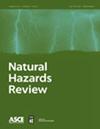Impact of COVID-19 on the Diversity of the Construction Workforce
IF 2.2
3区 工程技术
Q3 ENGINEERING, CIVIL
引用次数: 7
Abstract
Construction industry employment has been severely impacted by the coronavirus (COVID-19) pandemic. This paper examines the impact of the COVID-19 pandemic in the US construction labor market. This study contributes to the state of knowledge by (1) revealing how the COVID-19 pandemic impacted construction employment across different demographic groups and geographic regions in the US, and (2) identifying vulnerable demographic groups (e.g., minorities, women, older workers) in the construction workforce that are disproportionally impacted by the pandemic. Employment data from the Current Population Survey and Current Employment Statistics (CES) programs, which are administered by the Bureau of Labor Statistics, are used to assess the impact of COVID-19 on construction employment. The impact of COVID-19 is defined as a change in 12-month employment from 2019 to 2020;the study mostly focuses on April and September, 2020. Analyzing CES survey data reveals that women in the construction workforce declined by 11.9% in April 2020, when COVID-19 caused an overall 15.6% decline in the US construction labor market. The study also reveals that Black or African American communities are disproportionately impacted by job loss in the US construction industry. In September 2020, the 12-month decline in construction employment among Black or African Americans was 29.6%, compared to 5.8% for the overall decline in construction employment. States in the north of the US suffered a rapid decline in construction employment during the initial stage of the COVID-19 pandemic. Thirty states suffered a higher 12-month decline in construction average weekly earnings in September compared to April, which reveals the persistent impact of the pandemic on the industry. This study contributes to the state of practice by helping policymakers understand the pandemic’s disproportionate impact across different demographic groups and geographic regions. It is expected that this study will assist policymakers in drafting equitable recovery policies to overcome the setbacks caused by the pandemic.2019冠状病毒病对建筑劳动力多样性的影响
受新冠肺炎疫情影响,建筑业就业受到严重影响。本文考察了COVID-19大流行对美国建筑劳动力市场的影响。本研究通过(1)揭示COVID-19大流行如何影响美国不同人口群体和地理区域的建筑就业,以及(2)确定受大流行影响不成比例的建筑劳动力中的弱势人口群体(如少数民族、妇女、老年工人),为知识状态做出了贡献。由劳工统计局管理的当前人口调查和当前就业统计(CES)项目的就业数据用于评估COVID-19对建筑业就业的影响。2019冠状病毒病的影响被定义为2019年至2020年12个月就业的变化,研究主要集中在2020年4月和9月。对CES调查数据的分析显示,2020年4月,新冠肺炎疫情导致美国建筑劳动力市场总体下降15.6%,而建筑劳动力中的女性人数下降了11.9%。该研究还显示,黑人或非裔美国人社区受到美国建筑业失业的影响不成比例。2020年9月,黑人或非洲裔美国人在建筑业就业的12个月下降了29.6%,而建筑业就业的总体下降了5.8%。在2019冠状病毒病大流行初期,美国北部各州的建筑业就业迅速下降。与4月份相比,30个州9月份建筑业平均每周收入的12个月跌幅更大,这表明疫情对该行业的持续影响。这项研究有助于政策制定者了解这一流行病对不同人口群体和地理区域的不成比例的影响,从而改善实践状况。预计这项研究将有助于决策者起草公平的复苏政策,以克服大流行病造成的挫折。
本文章由计算机程序翻译,如有差异,请以英文原文为准。
求助全文
约1分钟内获得全文
求助全文
来源期刊

Natural Hazards Review
ENGINEERING, CIVIL-GEOSCIENCES, MULTIDISCIPLINARY
CiteScore
4.90
自引率
7.40%
发文量
72
审稿时长
3 months
期刊介绍:
The Natural Hazards Review addresses the range of events, processes, and consequences that occur when natural hazards interact with the physical, social, economic, and engineered dimensions of communities and the people who live, work, and play in them. As these conditions interact and change, the impact on human communities increases in size, scale, and scope. Such interactions necessarily need to be analyzed from an interdisciplinary perspective that includes both social and technical measures. For decision makers, the risk presents the challenge of managing known hazards, but unknown consequences in time of occurrence, scale of impact, and level of disruption in actual communities with limited resources. The journal is dedicated to bringing together the physical, social, and behavioral sciences; engineering; and the regulatory and policy environments to provide a forum for cutting edge, holistic, and cross-disciplinary approaches to anticipating risk, loss, and cost reduction from natural hazards. The journal welcomes rigorous research on the intersection between social and technical systems that advances concepts of resilience within lifeline and infrastructure systems and the organizations that manage them for all hazards. It offers a professional forum for researchers and practitioners working together to publish the results of truly interdisciplinary and partnered approaches to the anticipation of risk, loss reduction, and community resilience. Engineering topics covered include the characterization of hazard forces and the planning, design, construction, maintenance, performance, and use of structures in the physical environment. Social and behavioral sciences topics include analysis of the impact of hazards on communities and the organizations that seek to mitigate and manage response to hazards.
 求助内容:
求助内容: 应助结果提醒方式:
应助结果提醒方式:


